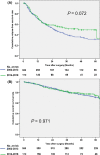Changes in patient background and prognosis after hepatectomy for hepatocellular carcinoma by hepatitis virus infection status: New trends in Japan
- PMID: 34337304
- PMCID: PMC8316744
- DOI: 10.1002/ags3.12451
Changes in patient background and prognosis after hepatectomy for hepatocellular carcinoma by hepatitis virus infection status: New trends in Japan
Abstract
Aim: Hepatitis C virus (HCV) infection is a major cause of hepatocellular carcinoma (HCC) in Japan. However, the cause and prognosis of HCC may be dramatically changed by direct acting antiviral agents (DAAs). Although the 2015 nationwide survey used a large cohort, its findings may be outdated. The present study therefore aimed to show the latest outcomes by patients' hepatitis virus infection status.
Methods: We included 552 patients who underwent hepatectomy for primary HCC between 2002 and 2018 and compared clinical factors between those treated before 2014 (n = 380) and after 2014 (n = 172), when DAAs became available.
Results: Distribution of hepatitis virus infection status between the two groups differed significantly (P < 0.001). In the earlier group, 46% of the patients had HCC with HCV infection (C-HCC), whereas the rate of C-HCC decreased (31%) and 54% of the patients had HCC with no hepatitis virus infection (NBNC-HCC) in the latter group. The proportion of HCC with hepatitis B virus infection (B-HCC) and the prognosis of B-HCC did not significantly change between the two groups. Among patients with C-HCC, the latter patients had significantly longer relapse-free survival (RFS) than the earlier patients (P = 0.033). However, RFS did not significantly differ between the earlier and latter patients with NBNC-HCC.
Conclusion: Postoperative prognosis has changed according to patients' hepatitis virus infection status. The proportion of patients with NBNC-HCC has increased, but their prognosis has not been improved. Treatment strategies for NBNC-HCC should be established.
Keywords: direct acting antiviral agents; hepatitis virus infection status; hepatocellular carcinoma; prognosis.
© 2021 The Authors. Annals of Gastroenterological Surgery published by John Wiley & Sons Australia, Ltd on behalf of The Japanese Society of Gastroenterological Surgery.
Conflict of interest statement
Conflict of Interest: All authors have no conflict of interest regarding the current study. Funding: No funding was received for this study.
Figures


Similar articles
-
A comparison of the surgical outcomes among patients with HBV-positive, HCV-positive, and non-B non-C hepatocellular carcinoma: a nationwide study of 11,950 patients.Ann Surg. 2015 Mar;261(3):513-20. doi: 10.1097/SLA.0000000000000821. Ann Surg. 2015. PMID: 25072437
-
Postoperative Outcomes for Patients with Non-B Non-C Hepatocellular Carcinoma: A Subgroup Analysis of Patients with a History of Hepatitis B Infection.Ann Surg Oncol. 2015 Dec;22 Suppl 3:S1034-40. doi: 10.1245/s10434-015-4845-0. Epub 2015 Sep 8. Ann Surg Oncol. 2015. PMID: 26350363
-
Outcomes after hepatectomy of patients with positive HBcAb Non-B Non-C hepatocellular carcinoma compared to overt hepatitis B virus hepatocellular carcinoma.Clin Transl Oncol. 2020 Mar;22(3):401-410. doi: 10.1007/s12094-019-02141-8. Epub 2019 Jun 6. Clin Transl Oncol. 2020. PMID: 31172445
-
Clinical characteristics and prognosis of non-B, non-C hepatocellular carcinoma: The impact of patient sex on disease-free survival - A retrospective cohort study.Int J Surg. 2017 Mar;39:206-213. doi: 10.1016/j.ijsu.2017.01.110. Epub 2017 Feb 1. Int J Surg. 2017. PMID: 28159713
-
Influence of viral hepatitis status on prognosis in patients undergoing hepatic resection for hepatocellular carcinoma: a meta-analysis of observational studies.World J Surg Oncol. 2011 Sep 21;9:108. doi: 10.1186/1477-7819-9-108. World J Surg Oncol. 2011. PMID: 21933440 Free PMC article. Review.
Cited by
-
The Impact of TP53-Induced Glycolysis and Apoptosis Regulator on Prognosis in Hepatocellular Carcinoma: Association with Tumor Microenvironment and Ferroptosis.Liver Cancer. 2024 Aug 12;14(1):36-57. doi: 10.1159/000540180. eCollection 2025 Mar. Liver Cancer. 2024. PMID: 40144470 Free PMC article.
-
Trends in long-term outcomes of patients with HCV-associated hepatocellular carcinoma after hepatectomy: A comparison before and after introduction of direct-acting antivirus therapy.Ann Gastroenterol Surg. 2023 Aug 7;8(1):133-142. doi: 10.1002/ags3.12725. eCollection 2024 Jan. Ann Gastroenterol Surg. 2023. PMID: 38250678 Free PMC article.
-
FIB-3 index as a novel age-independent predictor of liver fibrosis and prognosis in hepatocellular carcinoma patients undergoing hepatectomy.Ann Gastroenterol Surg. 2025 Apr 13;9(5):1055-1065. doi: 10.1002/ags3.70010. eCollection 2025 Sep. Ann Gastroenterol Surg. 2025. PMID: 40922911 Free PMC article.
-
Clinical significance of the Naples prognostic score in predicting short- and long-term postoperative outcomes of patients with hepatocellular carcinoma.World J Surg. 2025 Feb;49(2):502-511. doi: 10.1002/wjs.12448. Epub 2024 Dec 4. World J Surg. 2025. PMID: 39631788 Free PMC article.
-
Perioperative predictors of outcome of hepatectomy for HBV-related hepatocellular carcinoma.Front Oncol. 2023 Jul 13;13:1230164. doi: 10.3389/fonc.2023.1230164. eCollection 2023. Front Oncol. 2023. PMID: 37519791 Free PMC article. Review.
References
-
- Vital statistics, Ministry of Health, Labour and Welfare. Available from: http://www.mhlw.go.jp/english/database/db‐hw/vs01.html Cited 25 September 2017.
-
- Toyoda H, Tada T, Johson PJ, Izumi N, Kadoya M, Kaneko S, et al. Validation of serological models for staging and prognostication of HCC in patients from a Japanese nationwide survey. J Gastroenterol. 2017;52(10):1112–21. - PubMed
-
- Umemura T, Ichijo T, Yoshizawa K, Tanaka E, Kiyosawa K. Epidemiology of hepatocellular carcinoma in Japan. J Gastroenterol. 2009;44(Suppl 19):102–7. - PubMed
-
- Nishikawa H, Osaki Y. Non‐B non‐C hepatocellular carcinoma (review). Int J Oncol. 2013;43(5):1333–42. - PubMed
-
- Utsunomiya T, Shimada M. Molecular characteristics of non‐cancerous liver tissue in non‐B non‐C hepatocellular carcinoma. Hepatol Res. 2011;41(8):711–21. - PubMed
LinkOut - more resources
Full Text Sources

